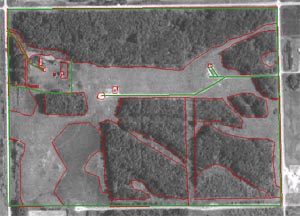| | A good woodlot resource inventory can help landowners make important decisions regarding their woodlot’s potential, capabilities, and current state. It can also help determine management and long-term land-use options. Once landowners have defined their goals and objectives, a woodlot resource inventory is the first step in developing a woodlot management plan. Land management decisions should be made using an accurate and complete inventory.
How can I conduct a resource inventory?
There are several steps that landowners should consider:
- Determine the goals of the inventory – list the information you want recorded, determine the level of detail you require, decide when you’re going to start and how much it will cost.
- Assemble general information about the site – legal land location, soil information, watershed data, topographic maps, aerial photos, and other geographic information. This may also include obtaining books, information bulletins and fact sheets on wildlife, trees and plants. Further information can be obtained from provincial forestry or agricultural departments.
- Prepare resource maps of the land –separate your woodlot into the different forest stands as well as other land features.
- Prepare for field work – locate the plot locations and line of traveling on a map, assemble equipment and tally form for inventory.
- Conduct the inventory – walk through your woodlot and document the information you want recorded.
- Analyze and summarize the field data – calculate volumes for each plot and all stands, verify vegetation type and other features from your map. Summarize the data that can be used for a management plan.
- Update the inventory as required – a forest is not static and goes through the changes just as your objectives can change over time.

Woodlot map using air photos as background
What kind of information should I inventory?
A resource inventory should contain information about the trees and characteristics land in the woodlot. It can be as detailed as the landowner desires depending on their goals and objectives for the woodlot.
The following information can be collected:
- Tree information - tree species, age, number of trees per acre/hectare, timber volume, growth and basal area should also measured.
- Understory vegetation information, forest floor vegetation, and any unique or rare vegetation.
- Soil type, wildlife species, wetlands, streams and drainage information.
- Land feature information such as woodlot boundaries, trails, fences, roads, campsites, viewpoints and other special features.
What is timber cruising?
Timber cruising is measuring standing trees to determine the volume and value of the trees on a given area of land. After stand boundaries have been located, the timber cruising can be designed. This information is usually collected through representative sample plots. The radius of each plot is usually 7.98 m (26.2 feet). During the cruising you can also gather and map additional resource data of the woodlots. Within each plot the following information can be recorded:
- Plot number and cover type (tree species type).
- Number of trees (this number can later be converted into the number of trees per hectare).
- Diameter at breast height - DBH (1.47 m or 4.5 feet).
- Height of the stand (this number can be used for the average stand height).
- Tree ages.
- Growth rate.
- Health and vigor.
- Defects or evidence of rot or stand deterioration.
- Under story vegetation and regeneration.
Most of this plot information may or may not collect but the DHB and tree height must be taken because for timber volume calculation. Determining the forest and tree age is very important for management purpose.
You can find more detailed woodlot inventory information in “ Woodlot Management Guide for Prairie Provinces” which could be obtained through Woodlot Association of Alberta.
For more information on woodlots please contact:
Toso Bozic
Sustainable Woodlot Specialist
Alberta Agriculture, Food and Rural Development
RR 6, 17507 Fort Road
Edmonton, AB T5B 4K3
Phone: 780-415-2681
Fax: 780-422-6096
Cell: 780-940-6107 |
|